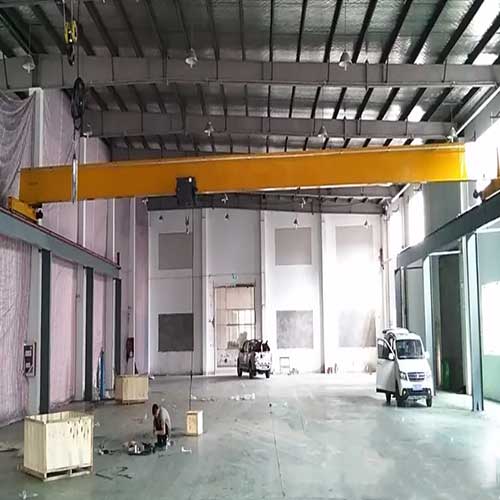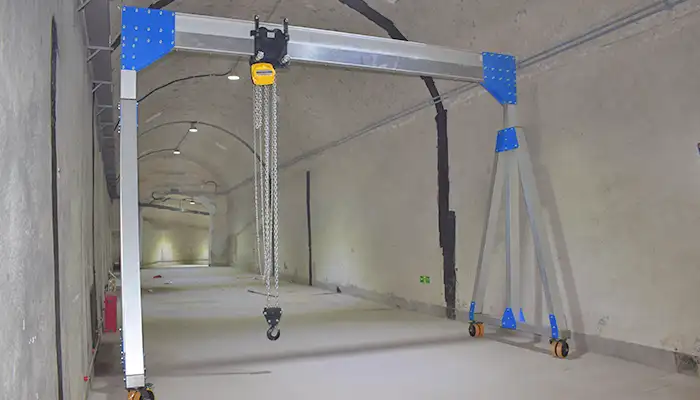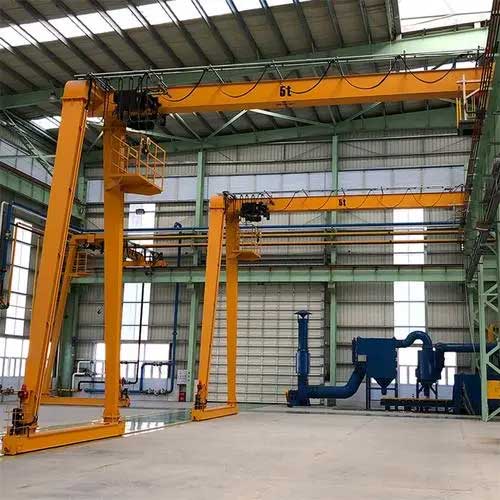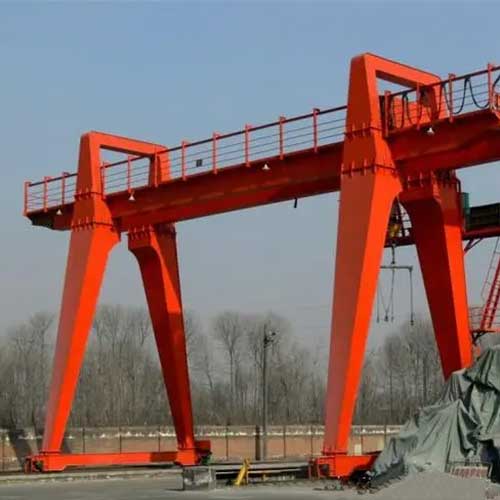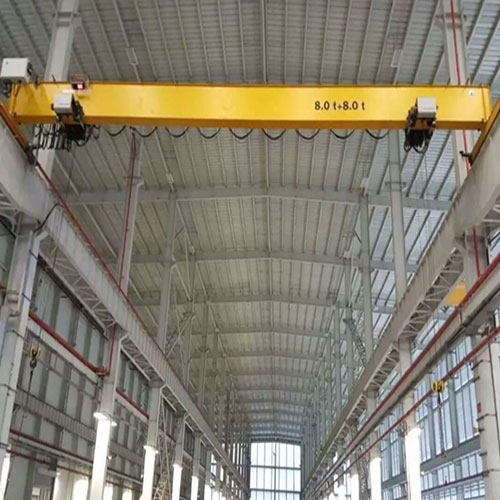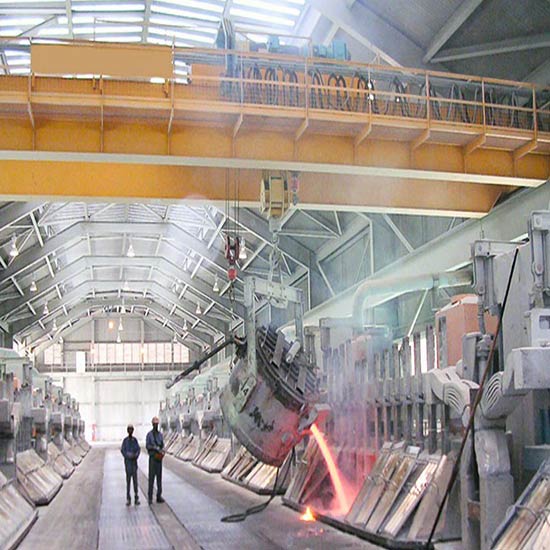Single Girder Overhead Travelling Cranes, Buy 3 Ton, 5 Ton, 10 Ton Crane
Single girder overhead travelling crane for industrial uses, with single girder & double girder, top running & underhung bridge crane design 1 ton to 10 ton.
Category: Travelling Crane
Your Trusted Overhead Travelling Crane Manufacturer & Supplier
Single Girder Overhead Travelling Cranes, Buy 3 Ton, 5 Ton, 10 Ton Crane
Single Beam Overhead Travelling Bridge crane with Top Running & Underhung Crane Design 1 Ton to 20 Ton
Single girder overhead travelling crane for industrial uses, with top running & underhung bridge crane design 1 ton to 10 ton.
Single Girder Overhead Travelling Cranes: A Comprehensive Guide
Single Girder Overhead Travelling Cranes, often referred to as bridge cranes, are an integral part of material handling systems in numerous industries worldwide. These cranes are engineered with a single bridge beam, providing exceptional lifting capabilities and maneuverability. Their purpose lies in efficiently lifting and transporting materials within a defined area in factories, warehouses, construction sites, and more.
These cranes consist of a single horizontal bridge beam that supports a hoist and trolley. They operate by running along elevated runways or tracks, enabling them to cover a designated workspace. The primary function of single girder overhead travelling cranes is to streamline material handling processes, aiding in the efficient movement of goods or heavy loads within a facility.
Importance and Applications in Various Industries
The versatility and adaptability of single girder overhead travelling cranes make them indispensable across a wide array of industries. In manufacturing plants, they facilitate the lifting and transfer of raw materials and finished products. Within warehouses, these cranes efficiently organize inventory and assist in loading and unloading tasks. In construction sites, they aid in the transportation of heavy equipment and materials.
Their applications span across industries such as automotive, steel, aerospace, logistics, shipbuilding, and more. Wherever there is a need for lifting and moving substantial loads in a controlled manner, single girder overhead travelling cranes prove invaluable.
These cranes offer numerous advantages, including cost-effectiveness, space optimization, and ease of installation. Their significance in enhancing operational efficiency while ensuring safety underscores their relevance in modern industrial settings.
In the subsequent sections of this comprehensive guide, we will delve deeper into the components, types, factors to consider, safety measures, installation procedures, and real-life applications of single girder overhead travelling cranes. Understanding these aspects will provide a holistic view, aiding both potential buyers and existing users in maximizing the benefits these cranes offer within their respective industries.
Components of Single Girder Overhead Travelling Cranes
Single girder overhead travelling cranes consist of several key components, each playing a crucial role in their functionality and efficiency.
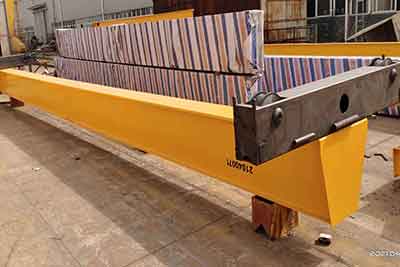
The main structural element of these cranes is the girder, which supports the hoist and trolley mechanism. Typically constructed from steel, these girders come in various designs and configurations, tailored to specific load-bearing requirements. The choice of material and design ensures durability, strength, and stability during lifting operations.
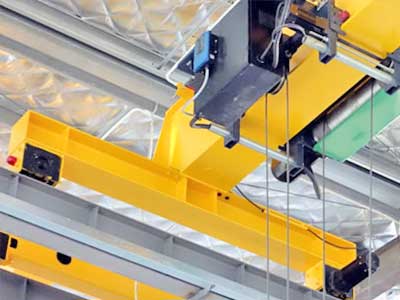
End trucks, mounted on either side of the girder, contain wheels or trolley systems that enable the crane to traverse along the runway beams. Runway beams, installed at an elevated level within the facility, provide the track system for the crane's movement. These components are crucial for the smooth and controlled horizontal motion of the crane within the workspace.

The hoist mechanism, attached to the girder, is responsible for lifting and lowering loads. Equipped with chains, wire ropes, or other lifting mediums, the hoist provides the necessary lifting capacity. The trolley mechanism moves horizontally along the girder, allowing precise placement of loads.

Electrical Components and Controls
Electrical components such as motors, brakes, limit switches, and control panels, vfd control are integral parts of single girder overhead travelling cranes. These components ensure smooth operation, precise control over movements, and safety features like overload protection and emergency braking systems. Advanced control panels facilitate user-friendly operation, offering features like variable speed control and programmable operations.
The synergy among these components forms the backbone of single girder overhead travelling cranes, enabling them to perform lifting tasks efficiently and safely. Regular maintenance and inspections of these components are crucial to ensure optimal functionality and longevity of the crane system. Understanding the role of each component is vital for users and buyers in making informed decisions regarding maintenance schedules, upgrades, or replacements to maximize the crane's performance and lifespan.
Advantages of Single Girder Overhead Travelling Cranes
Single girder overhead travelling cranes offer a range of advantages that make them a preferred choice in various industrial settings.
Cost-Effectiveness and Space Efficiency
One of the significant advantages of single girder overhead travelling cranes is their cost-effectiveness. Compared to double girder cranes, they often require lower initial investment and have reduced maintenance costs. Their design allows for efficient use of space, utilizing minimal headroom and offering maximum floor space utilization. This space efficiency translates into cost savings and increased productivity within a workspace.
Versatility in Handling Light to Moderate Loads
These cranes are well-suited for handling light to moderate loads efficiently. With their precise lifting capabilities and maneuverability, they excel in tasks that involve moving materials of various sizes within a specified area. This versatility makes them ideal for a wide range of applications across industries, accommodating diverse handling requirements.
Ease of Installation and Maintenance
Single girder overhead travelling cranes are relatively easier to install compared to their double girder counterparts. Their simpler structure and fewer components contribute to faster installation times, minimizing disruptions to operations. Moreover, they typically require less frequent maintenance due to their design simplicity, resulting in lower downtime and reduced maintenance costs over their operational lifespan.
These advantages collectively make single girder overhead travelling cranes an attractive option for businesses looking to enhance their material handling capabilities while optimizing costs and operational efficiency. Understanding these benefits allows companies to make informed decisions about integrating these cranes into their facilities, thereby improving their overall productivity and workflow management.
Types and Configurations of Single Girder Overhead Travelling Cranes
Single girder overhead travelling cranes come in various types and configurations, each tailored to specific operational needs and environments.
Top Running vs. Under Running Cranes

Top Running Cranes: These cranes have their end trucks riding on top of runway beams. They are suitable for heavy-duty applications and offer higher lifting capacities. Top running cranes are ideal for facilities where headroom is not a constraint.
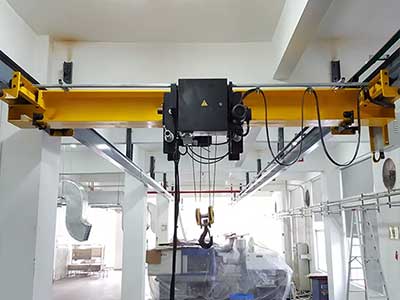
Under Running Cranes: Also known as underhung cranes, these feature end trucks that run underneath the runway beams. They are advantageous in situations where headroom is limited or when the building structure cannot support the weight of top running cranes. Under running cranes are often used in smaller workspaces or buildings with weight restrictions.
Single Girder vs. Double Girder Cranes
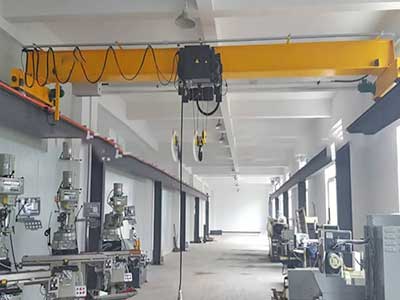
Single Girder Cranes: These cranes have a single horizontal girder supporting the hoist and trolley. They are suitable for light to moderate lifting applications and offer cost-effectiveness, ease of installation, and maintenance.
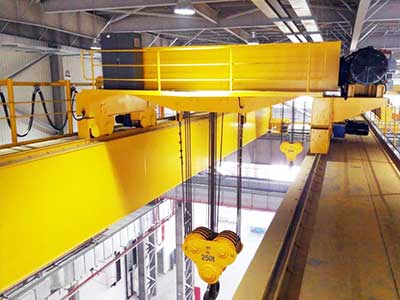
Double Girder Cranes: In contrast, double girder cranes have two parallel girders supporting the hoist mechanism. They are capable of handling heavier loads and provide greater lifting heights. Double girder cranes are commonly used in heavy industrial applications requiring higher lifting capacities.
Different Lifting Mechanisms and Attachments
Single girder overhead travelling cranes can be equipped with various lifting mechanisms and attachments to cater to specific material handling needs:
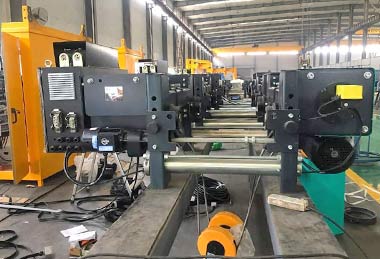
Wire Rope Hoists: Commonly used for higher lifting capacities, wire rope hoists provide smooth and precise lifting of heavier loads.
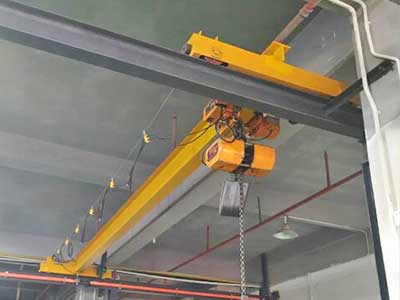
Chain Hoists: These hoists are versatile and reliable for lighter loads and offer ease of maintenance.

Attachments: Cranes can be equipped with specialized attachments like hooks, magnets, grabs, or specialized lifting beams tailored to handle specific types of materials or products.
Understanding the different types and configurations of single girder overhead travelling cranes allows businesses to choose the most suitable option based on their lifting requirements, space constraints, and operational environments. It's essential to assess the specific needs of the application to select the crane type that optimizes efficiency and productivity.
Your Trusted Overhead Travelling Crane Manufacturer & Supplier
Applications of Single Girder Overhead Travelling Cranes
Single girder overhead travelling cranes find extensive applications across diverse industrial sectors due to their versatility, efficiency, and adaptability. They cater to indoor and outdoor settings, serving specific needs in various industries.
Indoor Use Across Various Industrial Sectors:
The single girder overhead travelling cranes play a crucial role in manufacturing units by facilitating the movement of raw materials, components, and finished products. Industries such as automotive, electronics, and consumer goods utilize these cranes for assembly lines, warehousing, and logistics. In warehouses and distribution centers, single girder overhead travelling cranes assist in organizing inventory, loading and unloading shipments, and optimizing storage space efficiently. They aid in handling rolls of fabric, transporting goods between workstations, and facilitating material movement in textile and apparel manufacturing plants. Cranes in this sector are used for handling raw materials, packaging, and equipment, ensuring smooth operations and compliance with stringent hygiene standards. In pharmaceutical facilities, these cranes assist in lifting and transporting delicate equipment and materials, ensuring precise and safe handling.

Manufacturing:
- Automotive Industry: These cranes are pivotal in automotive manufacturing plants, supporting the assembly of vehicles by transporting heavy components such as engines, chassis, and body parts along production lines. They facilitate efficient movement between workstations, aiding in the assembly process and enhancing production speed.
- Electronics Manufacturing: In electronics manufacturing, precision and careful handling are paramount. Single girder overhead travelling cranes assist in transporting delicate electronic components and devices, ensuring damage-free movement and contributing to streamlined production processes.
- Consumer Goods Production: Industries producing consumer goods benefit from these cranes for moving raw materials and finished products across different production stages. They support the efficient handling of items like appliances, furniture components, and other consumer goods.

Warehousing and Logistics:
- Inventory Management: Single girder overhead travelling cranes in warehouses aid in organizing and managing inventory efficiently. They assist in stacking and retrieving goods, optimizing available space, and enabling quick and accurate access to stored items.
- Loading and Unloading: Within distribution centers, these cranes play a crucial role in loading and unloading shipments from trucks and containers. They expedite these processes, reducing handling time and minimizing the risk of product damage.

- Fabric Handling: Single girder overhead travelling cranes are used for transporting and handling rolls of fabric within textile manufacturing plants. They facilitate the movement of large and heavy fabric rolls between different stages of production, ensuring smooth workflow and minimizing manual handling.
- Workstation Transport: These cranes aid in the movement of garments or textile materials between workstations, ensuring efficient production lines and timely completion of tasks.

Food and Beverage:
- Raw Material Handling: Cranes in this sector assist in the safe handling of raw materials such as ingredients, packaging materials, and equipment used in food production processes. They ensure hygienic practices and minimize the risk of contamination.
- Equipment Transport: They are employed for transporting heavy machinery and equipment within food and beverage facilities, supporting maintenance tasks and ensuring smooth operations while adhering to strict hygiene standards.

Pharmaceuticals:
- Equipment and Material Handling: Single girder overhead travelling cranes in pharmaceutical facilities aid in the safe and precise movement of sensitive equipment and materials used in drug manufacturing. They contribute to maintaining sterile environments and adhering to strict quality control measures.
In these indoor industrial sectors, single girder overhead travelling cranes serve as indispensable tools, offering efficiency, precision, and safety in material handling processes. Their adaptability across various industries underscores their versatility and importance in optimizing workflows and ensuring the smooth functioning of operations.
Outdoor Use Across Various Industrial Sectors:
Single girder overhead travelling cranes support construction activities by lifting heavy construction materials, tools, and equipment on building sites.
They are essential in shipyards and ports for assembling ship components, loading and unloading cargo, and maintaining vessels.In mining operations, these cranes assist in moving extracted materials, machinery, and heavy loads within mining sites.

Construction:
- Material Handling: Single girder overhead travelling cranes play a pivotal role in construction sites by lifting and transporting heavy construction materials such as steel beams, concrete blocks, and pre-fabricated components. They aid in optimizing construction workflows by efficiently moving materials across the site.
- Equipment Handling: These cranes assist in lifting and positioning construction machinery and equipment at different locations within the construction site, contributing to the smooth operation of various tasks.

Shipbuilding and Ports:
- Ship Assembly: In shipyards, these cranes are crucial for assembling ship components, including large sections of the vessel's structure. They facilitate the movement of heavy parts, allowing precise positioning and efficient assembly of ships.
- Cargo Handling: At ports, single girder overhead travelling cranes handle the loading and unloading of cargo from ships onto docks or storage areas. They are adept at managing containers, heavy machinery, and other cargo items efficiently.

Single Girder Grab Overhead Crane for Mining and Quarrying:
- Material Transport: In mining operations, these cranes assist in moving extracted materials such as ores, rocks, and other heavy loads within mining sites or quarries. They contribute to the efficient transport of materials from extraction points to processing or storage areas.
- Equipment Handling: Single girder overhead travelling cranes are instrumental in handling heavy mining equipment and machinery, ensuring their precise movement and positioning, thus supporting mining operations effectively.
In outdoor industrial settings, single girder overhead travelling cranes provide indispensable support by efficiently handling heavy loads, materials, and equipment. Their robustness, lifting capacity, and adaptability to outdoor environments make them essential tools in construction sites, shipyards, ports, and mining areas, contributing significantly to productivity and operational efficiency.
Hazardous Use in Particular Sectors:
Certain sectors involve hazardous environments where specialized cranes are necessary:
These single girder overhead travelling cranes are adapted for use in hazardous environments, providing explosion-proof or spark-resistant features to ensure safety when handling volatile materials. In refineries and oil rigs, where flammable substances are present, cranes are specially designed to meet stringent safety requirements and operate in hazardous zones.And, also, the overhead travelling bridge cranes are used in foundries or handling heavy metals are equipped with heat-resistant materials and safety measures to withstand extreme temperatures and harsh conditions.
In hazardous environments, specialized single girder overhead travelling cranes are essential for maintaining safety standards. Here are further insights into their use in specific hazardous sectors:

Chemical and Petrochemical Industries:
Explosion-Proof Features: Cranes used in chemical and petrochemical industries are equipped with explosion-proof features, including specialized coatings, enclosures, and spark-resistant components. These safety measures prevent potential ignition sources and ensure safe handling of volatile and flammable materials.

Oil and Gas:
Zone-Classified Cranes: Refineries and oil rigs require cranes designed to operate in hazardous zones classified according to their risk levels. These cranes comply with stringent safety regulations and are constructed with materials and components capable of withstanding flammable atmospheres and preventing sparks or ignition.

Heavy Metals and Foundries:
Heat-Resistant Design: Cranes used in foundries or handling heavy metals are designed with heat-resistant materials to withstand extreme temperatures encountered in these environments. They have protective coatings and specialized features to ensure safe operation in high-temperature conditions.
These specialized single girder overhead travelling cranes undergo rigorous design and construction to meet specific safety standards in hazardous sectors. They prioritize safety by incorporating features that prevent potential risks such as sparks, explosions, or heat-related accidents. By adhering to strict safety regulations and employing specialized designs, these cranes enable safe and efficient material handling in environments where the potential for hazardous incidents is higher.
Specialized Single Girder Overhead Travelling Cranes Designed for Various Industrial Sectors
Specialized single girder overhead travelling cranes are tailored to meet specific requirements across various industrial sectors. Here are examples of such specialized cranes designed for different industries:

Clean Room Cranes for Semiconductor and Electronics Industries:
These cranes are built to operate in clean room environments, ensuring minimal particle generation. They feature stainless steel components and specialized coatings to meet stringent cleanliness standards required in semiconductor and electronics manufacturing.
Design and Configuration:
- Constructed with stainless steel components to prevent particle generation.
- Sealed motors and components to minimize contamination.
- Smooth surfaces and minimized crevices to facilitate easy cleaning.
Features:
- Stainless steel construction for corrosion resistance.
- Enclosed components to prevent particle emission.
- Precision controls for delicate handling of electronics.
Benefits:
- Maintains clean room standards by minimizing particle generation.
- Prevents contamination of sensitive electronic components.
Applications:
- Semiconductor manufacturing.
- Electronics assembly.

Explosion-Proof Cranes for Chemical and Petrochemical Industries:
Cranes used in these industries are designed to prevent sparks and are constructed with explosion-proof materials. They often include enclosures, spark-resistant components, and protective measures to handle volatile substances safely.
Design and Configuration:
- Enclosed motors and electrical components to prevent sparks.
- Spark-resistant materials and coatings to mitigate explosion risks.
- Controlled operating speeds to avoid ignition.
Features:
- Explosion-proof wiring and enclosures.
- Non-sparking components.
- Overload protection and emergency shut-off systems.
Benefits:
- Ensures safety in environments with flammable substances.
- Reduces the risk of explosions or fires.
Applications:
- Chemical processing plants.
- Petrochemical refineries.

Aseptic and Hygienic Cranes for Food and Pharmaceutical Industries:
Aseptic cranes for the food and pharmaceutical sectors are constructed with materials that resist corrosion and bacterial growth. They comply with strict hygiene standards and are designed to facilitate easy cleaning to maintain aseptic conditions.
Design and Configuration:
- Stainless steel or anti-corrosive material construction.
- Smooth surfaces and rounded edges to prevent bacterial growth.
- Easily accessible areas for thorough cleaning.
Features:
- Corrosion-resistant materials.
- Sealed electrical components.
- Hygienic design to meet stringent cleanliness standards.
Benefits:
- Maintains sanitary conditions in food and pharmaceutical production.
- Prevents contamination of products.
Applications:
- Food processing plants.
- Pharmaceutical manufacturing.

High-Temperature Resistant Cranes & Ladle Hoist Crane for Foundries and Heavy Metals:
Cranes used in foundries and handling heavy metals are equipped with heat-resistant materials, protective coatings, and specialized features to withstand extreme temperatures encountered in these environments.
Design and Configuration:
- Heat-resistant materials to withstand extreme temperatures.
- Insulated components to prevent heat transfer.
- Specialized coatings for protection against high-temperature environments.
Features:
- Heat-resistant wires and electrical insulation.
- Structural elements capable of withstanding high temperatures.
Benefits:
- Ensures crane functionality in high-temperature environments.
- Reduces maintenance and repairs caused by heat-related wear.
Applications:
- Foundries.
- Heavy metal manufacturing.

Zone-Classified Cranes for Oil and Gas Industry:
In the oil and gas sector, cranes are built to operate in hazardous zones, classified according to the risk of explosion. These cranes are designed to mitigate risks associated with flammable substances present in these environments.
Design and Configuration:
- Zone-specific certifications for hazardous areas.
- Sealed components to prevent ignition.
- Corrosion-resistant materials for offshore environments.
Features:
- Explosion-proof enclosures and electrical fittings.
- Corrosion-resistant coatings.
- Comprehensive safety systems for hazardous zones.
Benefits:
- Ensures safe operations in environments with flammable substances.
- Prevents potential accidents or explosions.
Applications:
- Oil refineries.
- Offshore oil rigs.

Water-Resistant Cranes for Marine and Shipbuilding:
Cranes used in shipyards and marine environments are designed to resist corrosion from saltwater exposure. They feature water-resistant coatings and materials to withstand harsh marine conditions.
Design and Configuration:
- Corrosion-resistant materials for marine environments.
- Sealed components to prevent water ingress.
- Robust coatings to withstand saltwater exposure.
Features:
- Stainless steel components.
- Protective coatings for longevity.
- Water-resistant electrical fittings.
Benefits:
- Maintains functionality in harsh marine conditions.
- Reduces corrosion and extends crane lifespan.
Applications:
- Shipbuilding yards.
- Ports and marine terminals.
These specialized single girder overhead travelling cranes are purpose-built with unique design elements, materials, and features tailored to the specific demands and environmental constraints of each industry. Their designs ensure safe, efficient, and reliable operation in diverse and challenging industrial settings.Each specialized overhead travelling bridge crane is engineered with specific features, materials, and safety measures tailored to the unique demands of the respective industry. These specialized designs ensure that the cranes can function efficiently and safely within the particular environmental and operational constraints of each sector.
Comparisons of Overhead Travelling Crane Single Girder vs. double girder Design
Structural Design:
- Single Girder Crane: It consists of a single bridge beam attached to end trucks, providing support for the hoist and trolley. The design is lighter and more compact.
- Double Girder Crane: This type features two bridge beams, offering increased stability and higher lifting capacities. The trolley and hoist run between the two girders, providing better support and control.
Load Capacity:
- Single Girder Crane: Generally suited for handling lighter to moderate loads, typically up to 20 tons.
- Double Girder Crane: Offers higher load capacities, capable of lifting heavier loads, often exceeding 20 tons, making them suitable for heavy-duty applications.
Lifting Height and Hook Coverage:
- Single Girder Crane: Provides limited hook coverage and lifting height compared to double girder cranes due to its lower hook heights.
- Double Girder Crane: Offers higher hook coverage and increased lifting heights, ideal for applications requiring taller lifts or the handling of bulky loads.
Height and Space Requirements:
- Single Girder Crane: Requires less overhead clearance and space due to its compact design, making it suitable for facilities with height limitations.
- Double Girder Crane: Requires more vertical space due to its taller structure, making it more suitable for applications with ample overhead clearance.
Cost Consideration:
- Single Girder Crane: Generally more cost-effective in terms of initial investment, installation, and maintenance compared to double girder cranes.
- Double Girder Crane: Usually involves higher initial costs due to its heavier construction and higher load capacities.
Application Suitability:
- Single Girder Crane: Ideal for light to moderate lifting tasks and applications in smaller manufacturing units, workshops, and warehouses.
- Double Girder Crane: Suited for heavy-duty applications, large-scale manufacturing, foundries, steel mills, and facilities requiring higher lifting capacities.
Operational Efficiency and Control:
- Single Girder Crane: Offers good operational control and efficiency for tasks within its specified load capacities.
- Double Girder Crane: Provides better stability and control for handling heavier loads and offers enhanced precision and stability during lifting operations.
Both single girder and double girder overhead travelling cranes have their unique advantages and are suitable for different operational requirements. The choice between these crane types depends on factors such as load capacity, lifting height, space availability, budget, and the specific needs of the application or industry.
Electrically Operated Overhead Travelling Crane and Manual Operated Overhead Travelling Cranes
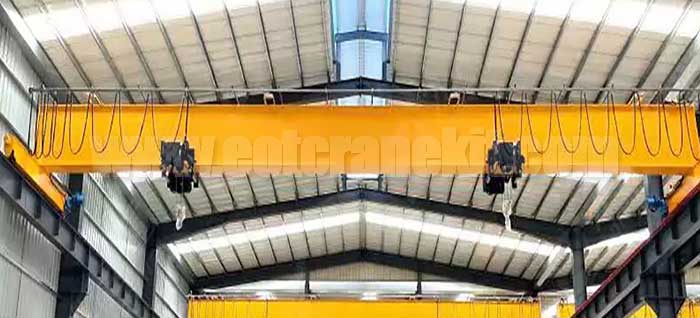
Single Girder Electrically Operated Overhead Travelling Crane:
Operation:
- Power Source: Electrically operated cranes are powered by electricity, utilizing motors for movement, lifting, and trolley travel.
- Control: They are controlled via pendant controls, radio controls, or cabin-operated consoles, offering precise and efficient handling.
Efficiency and Productivity:
- Efficiency: Electrically operated cranes offer higher efficiency due to their powered movement, enabling faster lifting, precise positioning, and smoother operations.
- Productivity: They contribute to increased productivity by reducing manual effort and providing faster material handling capabilities.
Load Capacity and Features:
- Load Handling: They are capable of handling a range of loads, typically up to moderate to heavy capacities, depending on the specific design and configuration.
- Additional Features: Electrically operated cranes often come equipped with safety features like overload protection, emergency stop functions, and advanced control systems.
Applications:
- Industrial Use: Suited for various industrial applications where efficient and frequent material handling is required, such as manufacturing, warehouses, and assembly lines.

Manual Operated Overhead Travelling Cranes:
Operation:
- Power Source: Manual cranes are operated by human effort, using hand chains or manual wheel-driven mechanisms to control movement, lifting, and trolley travel.
- Control: They rely on manual force and operator guidance for maneuvering and lifting loads.
Efficiency and Productivity:
- Efficiency: Manual cranes are generally slower and less efficient compared to electrically operated ones due to their reliance on human effort.
- Productivity: They might be suitable for lighter loads and intermittent lifting tasks but are less suitable for high-frequency or heavy-duty operations.
Load Capacity and Features:
- Load Handling: Limited in terms of load capacity, typically suitable for lighter loads within their specified range.
- Features: Manual cranes may lack advanced safety features and precision controls found in electrically operated cranes.
Applications:
- Lighter Duty Tasks: They are commonly used in small-scale operations, workshops, or areas with less frequent lifting needs or where power sources may be limited.
In summary, electrically operated single girder overhead travelling cranes offer higher efficiency, increased load capacities, precise controls, and are more suitable for heavy-duty and frequent material handling tasks across various industries. On the other hand, manual overhead travelling cranes are more basic, suitable for lighter loads and less frequent lifting tasks, often found in smaller-scale operations or where electricity is not readily available.
Factors to Consider Before Choosing a Single Girder Overhead Travelling Crane
Selecting the right single girder overhead travelling crane involves a careful evaluation of various factors to ensure it aligns with specific operational needs and safety requirements.
Load Capacity and Span Requirements
- Load Capacity: Determine the maximum weight the crane will need to lift and transport. It's crucial to choose a crane with adequate lifting capacity for the heaviest loads expected within your operations.
- Span Requirements: Assess the required span or distance the crane needs to cover. This includes the length of the runway beams and the area the crane will traverse to ensure it meets the spatial demands of the workspace.
Operating Environment and Conditions
- Indoor or Outdoor Use: Consider whether the crane will operate indoors, where space and height limitations might exist, or outdoors, where exposure to weather elements needs to be accounted for.
- Environmental Conditions: Evaluate factors such as temperature variations, humidity, dust, and corrosive elements present in the operating environment. These factors influence the choice of materials and coatings for durability and longevity.
Safety Features and Compliance with Standards
- Safety Standards: Ensure the crane complies with industry-specific safety standards and regulations. Consider safety features like overload protection, emergency braking systems, limit switches, and operator safety controls.
- Operator Training and Safety Protocols: Adequate training for crane operators is crucial. Ensure that the operators are well-trained in safe operation practices and emergency procedures.
Customization Options and Additional Accessories
- Customization: Assess whether the crane needs customization to meet specific operational requirements. This could involve modifications to the lifting mechanism, controls, or attachments.
- Additional Accessories: Consider additional accessories or attachments like hooks, lifting beams, or specialized grips tailored to handle specific materials or products. These can enhance the crane's versatility and efficiency in handling various loads.
Carefully considering these factors enables businesses to make informed decisions when selecting a single girder overhead travelling crane. By evaluating load capacities, operational environments, safety standards, and customization options, companies can choose a crane that not only meets their immediate requirements but also aligns with their long-term operational goals, ensuring enhanced productivity, safety, and efficiency.
Installation and Maintenance of Single Girder Overhead Travelling Bridge Crane
The successful installation and ongoing maintenance of a single girder overhead travelling crane are vital for its optimal performance, longevity, and safety within an industrial setting.
Pre-Installation Preparation and Site Assessment
- Site Assessment: Conduct a thorough analysis of the installation site to ensure it meets the crane's requirements in terms of structural support, clearance, and electrical connections.
- Structural Readiness: Ensure that the building structure can support the crane's weight and loads. This may involve reinforcing beams or structures as needed.
Installation Procedures and Safety Measures
- Installation Procedures: Follow manufacturer guidelines and industry best practices during installation. This includes assembling the crane components, mounting the runway beams, and ensuring proper alignment and leveling.
- Safety Measures: Implement safety protocols during installation to prevent accidents. This involves using proper lifting equipment, personal protective gear, and adhering to safety regulations.
Routine Maintenance Practices and Inspection Checks
- Scheduled Maintenance: Establish a routine maintenance schedule as per the manufacturer's recommendations. This includes lubrication, inspection of electrical components, and checking for wear and tear.
- Inspection Checks: Regularly inspect the crane's components, including hoists, trolleys, wiring, and controls, to identify potential issues before they escalate. Address any signs of wear, damage, or malfunction promptly.
Troubleshooting Common Issues
- Electrical and Mechanical Problems: Train maintenance personnel to troubleshoot common issues such as motor malfunctions, electrical faults, or brake problems.
- Emergency Procedures: Establish clear emergency protocols in case of equipment failure or safety hazards. This includes immediate shutdown procedures and contacting qualified technicians for repairs.
Proper installation and diligent maintenance procedures significantly contribute to the crane's operational efficiency and longevity. Regular inspections and adherence to maintenance schedules minimize downtime, ensure safe operations, and extend the crane's lifespan. Additionally, having a well-trained maintenance team capable of troubleshooting common issues efficiently enhances overall operational reliability.
Safety Measures and Regulations on Overhead Travelling Crane Single Girder
Safety is paramount when operating single girder overhead travelling cranes. Understanding and implementing safety measures and complying with regulations are crucial for accident prevention and ensuring a secure working environment.
Importance of Operator Training and Certification
- Operator Training: Adequate training for crane operators is essential to ensure safe and efficient crane operation. Training should cover crane controls, load handling, safety protocols, and emergency procedures.
- Certification: Operators should undergo certification programs or assessments to demonstrate their proficiency in operating the crane safely. Certification ensures competence and adherence to safety standards.
Safety Features and Emergency Protocols
- Safety Features: Single girder overhead travelling cranes come equipped with various safety features such as overload protection, limit switches, emergency stop buttons, and audible alarms to prevent accidents.
- Emergency Protocols: Establish clear emergency procedures for various scenarios, including power failures, equipment malfunctions, or accidents. This includes immediate shutdown protocols and evacuation plans.
Compliance with OSHA and Industry Standards
- OSHA Regulations: Adherence to Occupational Safety and Health Administration (OSHA) standards is mandatory. OSHA provides guidelines and regulations to ensure the safety of workers operating cranes, emphasizing inspections, load capacities, and operator training.
- Industry Standards: Complying with industry-specific standards and codes ensures that the crane meets safety requirements relevant to the particular sector. This includes adherence to electrical codes, structural standards, and crane safety guidelines.
Implementing comprehensive safety measures, providing adequate training to operators, and complying with safety regulations are essential for preventing accidents and maintaining a safe working environment. Prioritizing safety not only protects workers but also prevents costly damages and downtime associated with accidents or equipment failures. Regular inspections, safety audits, and continuous training programs contribute to a culture of safety within the workplace.
Cost Considerations and Return on Investment
Understanding the costs associated with acquiring and maintaining a single girder overhead travelling crane is crucial for businesses to make informed decisions and assess the return on investment (ROI) in the long run.
Initial Investment vs. Long-Term Benefits
- Initial Investment: Evaluate the upfront cost of purchasing the crane, considering factors like load capacity, customization, installation, and additional accessories required.
- Long-Term Benefits: Consider the long-term advantages such as increased productivity, efficiency, reduced labor costs, and minimized downtime that the crane will offer over its operational lifespan.
Factors Impacting Total Cost of Ownership
- Maintenance and Repairs: Assess the costs associated with routine maintenance, repairs, and replacement of parts over the crane's lifetime.
- Energy Consumption: Evaluate the energy efficiency of the crane to estimate operational costs and energy consumption.
- Downtime and Productivity Loss: Consider potential losses due to downtime caused by maintenance or unexpected breakdowns and how it impacts overall productivity.
- Lifecycle Costs: Evaluate the total lifecycle costs, including initial purchase, installation, ongoing maintenance, and eventual decommissioning or upgrades.
Calculating ROI and Cost-Saving Strategies
- ROI Calculation: Calculate the return on investment by comparing the total costs (initial investment, maintenance, operational costs) against the benefits (increased productivity, reduced labor costs) over the crane's lifespan.
- Cost-Saving Strategies: Implement strategies to optimize costs and enhance ROI, such as preventive maintenance plans, energy-efficient operations, training programs to minimize operator errors, and investing in quality components to reduce repair costs.
Considering the total cost of ownership, potential savings, and return on investment is essential when deciding to purchase a single girder overhead travelling crane. While the initial investment might seem significant, assessing the long-term benefits and cost-saving strategies will help in making a financially sound decision that aligns with the business's goals and objectives. Prioritizing efficiency, safety, and productivity alongside cost considerations ensures a balanced approach towards maximizing the benefits of the crane investment.
Real-life Applications and Case Studies
Single girder overhead travelling cranes have demonstrated their effectiveness and efficiency across diverse industries. Examining real-life applications and success stories showcases the practical benefits of these cranes in enhancing operational workflows and productivity.
Examples of Industries Using Single Girder Overhead Travelling Cranes
- Automotive Industry: Automotive manufacturing plants utilize single girder overhead travelling cranes for transporting vehicle components along assembly lines, improving efficiency and reducing manual handling.
- Warehousing and Logistics: Warehouses and distribution centers employ these cranes for managing inventory, loading and unloading shipments, and optimizing storage space efficiently.
- Steel and Metal Fabrication: Industries dealing with heavy materials such as steel and metal fabrication use these cranes for lifting and transporting raw materials and finished products within production facilities.
- Construction and Infrastructure: Single girder overhead travelling cranes play a pivotal role in construction sites for lifting construction materials, equipment, and aiding in the assembly of structural components.
Success Stories and Efficiency Gains
- Increased Productivity: Case studies reveal that implementing single girder overhead travelling cranes in manufacturing facilities has led to significant improvements in productivity, with reduced material handling time and increased throughput.
- Enhanced Safety: Real-life applications demonstrate how these cranes contribute to improved workplace safety by reducing manual handling, minimizing the risk of accidents, and ensuring controlled material movements.
- Cost Savings: Success stories often highlight the cost-effectiveness of these cranes, showcasing reduced labor costs, optimized space utilization, and minimized downtime due to efficient material handling.
- Workflow Optimization: Efficiency gains are observed in various industries where these cranes streamline processes, enabling smoother workflow management and ensuring timely deliveries.
Examining real-life applications and success stories underscores the diverse range of benefits single girder overhead travelling cranes offer across different industries. These case studies provide practical insights into the ways these cranes have positively impacted operations, improved safety standards, and enhanced overall productivity in various industrial settings.
Wrap it Up, to get Your Custom Single Girder Overhead Travelling Cranes
In conclusion, the discussion on single girder overhead travelling cranes has highlighted several crucial aspects:
- Definition and purpose: These cranes facilitate efficient material handling within various industries.
- Components and types: Understanding their components, types, and configurations is essential for choosing the right crane.
- Applications: Their versatile use indoors, outdoors, and in hazardous environments across diverse industries.
- Safety measures and regulations: Emphasizing operator training, compliance with safety standards, and the importance of safety features.
- Cost considerations: Balancing initial investment with long-term benefits and cost-saving strategies.
- Real-life applications: Demonstrating their efficacy in various industries through case studies and success stories.
Single girder overhead travelling cranes serve as indispensable assets in modern industrial settings. Their role in optimizing material handling processes, enhancing productivity, and ensuring safety cannot be overstated. These cranes offer versatility, cost-effectiveness, and efficiency, contributing significantly to streamlined operations across industries.
Recommendations and Next Steps for Potential Buyers/Users
For potential buyers or users considering the integration of single girder overhead travelling cranes into their operations, here are some recommendations and next steps:
- Assessment: Conduct a thorough assessment of load capacities, operational environments, and specific needs to determine the most suitable crane type and configuration.
- Compliance: Ensure compliance with safety regulations, operator training, and adherence to industry standards for safe and efficient crane operation.
- Maintenance Plan: Develop a comprehensive maintenance plan to ensure the crane's optimal performance and longevity.
- ROI Evaluation: Calculate the return on investment by considering both short-term costs and long-term benefits.
- Vendor Selection: Choose a reputable vendor or manufacturer offering quality cranes and reliable after-sales support.
Incorporating single girder overhead travelling cranes into operations requires careful planning and consideration. However, their contribution to improved efficiency, safety, and overall productivity makes them a valuable asset for businesses aiming to enhance their material handling capabilities.
Main Projects
Related Products
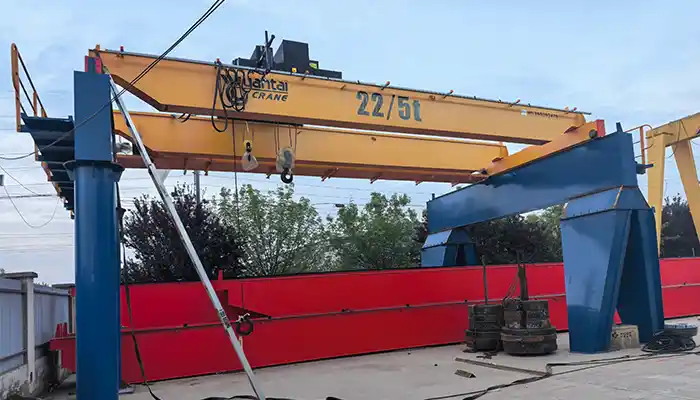
22/5 Ton Overhead Crane Double Hook System: Robust double girder crane with 22-ton main and 5-ton auxiliary hooks for heavy lifting. Get double hook crane!
Free consultation to Confirm Parameters & Specifications and Get
Latest Crane Price & Crane Rate.
- Types of overhead cranes : _______?
- Optional: Overhead travelling crane, goliath gantry crane,Slewing jib crane, Single girder or double girder crane,small portable crane or kbk crane, etc.
- Capacity of overhead crane: _______?
- Optional: 0.25ton, 0.5 ton, 1 ton, 2 ton, 3ton, 5 ton, 10 ton,15ton, 20ton, 25 ton, 30ton,35ton, up to 550ton, etc.
- Crane span & lifting height : _______?
- Crane travelling length : _____?
- Control of overhead crane:_______?
- Optional: pendant/ remote/cabin control
- Voltage supply of overhead crane:_____?
- Eg,: 380V50/60HZ,3Phase or others,etc.
- Application/usage of crane:_______?
- Eg,: Steel mill, ,injection mold, cement,stone, concrete,granite, general manufacturing, etc.
Just leave a message via the contact form and our hoist and crane engineer will contact you with in 24working hours.
Get In Touch
